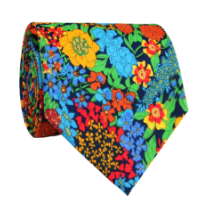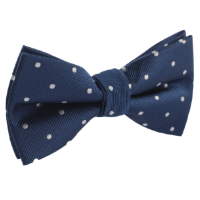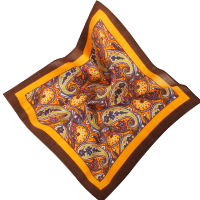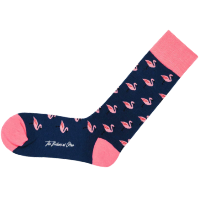How To Read Men's Dress Shirt Sizes
Navigating men's dress shirt sizes can be confusing. Still, it's essential for a polished look, whether for a job interview, formal event, or wardrobe update. This guide will help you understand sizing and confidently choose the perfect shirt. Knowing how to read men's dress shirt sizes ensures you pair your shirts seamlessly with accessories like bow ties and tailored suits.
How Men's Dress Shirt Sizes Work
Men's dress shirt sizes can seem complicated, but they generally follow two central systems: numerical sizing and alpha sizing. Knowing how to measure and size, dress shirts is essential to find the perfect fit. Here's a breakdown to help you navigate these systems effectively.
Numerical Sizing Explained
Numerical sizing uses two numbers to represent specific measurements. The first number indicates the neck size, ranging from 13 to 19 inches in half-inch increments. The second number represents the sleeve length. For example, a size "16-32/33" means:
Neck size: 16 inches
Sleeve length: 32 or 33 inches
For a precise fit, measure your neck circumference and arm length (from the centre of your back to your wrist). Use these measurements to find your size and consult brand size charts for accurate conversions.
Alpha Sizing Explained
Alpha sizing uses letters to represent general size categories like Small (S), Medium (M), Large (L), Extra Large (XL), and Double Extra Large (XXL). This system is less precise than numerical sizing. Still, it offers a more straightforward approach for those who prefer a more relaxed fit. Each alpha size corresponds to a range of neck and chest measurements, as shown below:
|
Alpha Size |
Neck Size (inches) |
Chest Size (inches) |
|
S |
14 - 14.5 |
34 - 36 |
|
M |
15 - 15.5 |
38 - 40 |
|
L |
16 - 16.5 |
42 - 44 |
|
XL |
17 - 17.5 |
46 - 48 |
|
XXL |
18 - 18.5 |
50 - 52 |
When choosing an alpha-sized shirt, consider your body type and preferred fit. Some brands offer variations like "slim fit" or "regular fit" within each size to accommodate different body shapes.
Critical Measurements for Men's Dress Shirts
Understanding key measurements is essential for finding the right fit. Here's how to measure yourself accurately for a men's dress shirt, including wrinkle-free options for a polished, low-maintenance look.
Neck Size
To measure your neck, wrap a flexible tape measure around the base where your collar typically sits. Ensure it is snug but not tight, leaving enough room for one or two fingers. This measurement usually ranges from 13 to 19 inches in half-inch increments. Finding well-fitting men's neckties that complement your dress shirts is crucial.
Sleeve Length
To measure your sleeve length, start from the back of your neck, over your shoulder, and down to your wrist bone. Keep your arm slightly bent for an accurate reading. Sleeve lengths are often given as two numbers (e.g., 32/33), indicating the sleeve can be adjusted to either length.
Chest Measurement
Measure around the widest part of your chest, under your armpits and across your shoulder blades. Keep the tape measure parallel to the ground. This measurement helps ensure a comfortable fit across your torso.
Shirt Length
Shirt length is crucial for a neat appearance, especially when tucked in. Measure from the base of your neck down your back to your desired length. The ideal length should cover your seat and hit mid-crotch, ensuring the shirt stays tucked in when you move or sit.
Waist Measurement
Measure around your natural waistline, usually just above your hip bones. Keep the tape measure parallel to the ground. This measurement helps determine how the shirt will fit around your midsection.
Dress Shirt Fit Types Based on Build
Slim Fit
Slim-fit shirts are tailored closer to the body with a tapered waist and narrower sleeves, creating a sleek, modern appearance. They are best for men with lean or athletic builds who prefer a fitted look that accentuates their physique.
Classic/Regular Fit
Classic-fit shirts offer a comfortable, traditional cut with more chest, waist, and armroom. They are versatile and suitable for various body types, making them an excellent choice for everyday wear and formal occasions. Pairing them with business ties can enhance their polished look, which is perfect for professional settings and special events.
Athletic Fit
Athletic-fit shirts are designed for men with broad shoulders and chests but smaller waists. They provide a tailored look while offering extra room for comfort and flexibility in critical areas.
How to Measure Yourself for a Dress Shirt
Measuring the Neck
Wrap a tape measure around the base of your neck, just above your collarbone. Leave enough room for two fingers between the tape and your neck to ensure comfort.
Measuring the Sleeves
Start from the back of your neck, over your shoulder, and down to your wrist bone. Keep your arm slightly bent for accuracy and round up to the nearest whole inch.
Measuring the Chest
Wrap the tape measure around the widest part of your chest, keeping it level and parallel to the floor. Measure the fullest part without pulling too tight.
Measuring the Waist
Measure around your natural waistline, typically just above your belly button. Keep the tape snug but not tight, and ensure it is level.
Common Dress Shirt Size Conversions For Men
Understanding size conversions is essential when shopping across different sizing systems or regions.
US to European Sizing
US and European sizes differ significantly. European sizes typically run smaller. For example, a size 15 in the US might correspond to a size 39 in Europe. Always refer to the brand's size chart for accurate conversions.
Casual Shirt to Dress Shirt Sizing
Casual shirts generally have a looser fit than dress shirts. If you wear a size Medium casual shirt, you might need a size 15.5/34 in dress shirts for a more tailored fit. Use your chest and sleeve measurements to find the closest match.
Frequently Asked Questions
How do I determine my dress shirt size?
Measure your neck circumference and sleeve length. For neck size, wrap the tape measure around the base of your neck. Measure from the back of your neck to your wrist bone for sleeve length.
What's the difference between numerical and alpha sizing?
Numerical sizing uses specific measurements like 16-32/33 for a more precise fit. In contrast, alpha sizing uses sizes like S, M, and L.
What are the critical measurements for finding the perfect fit?
The critical measurements are neck size, sleeve length, chest, waist, and shirt length.
What are the different dress shirt fit types?
The main fit types are slim fit, classic/regular fit and athletic fit, each designed to suit different body shapes.
How do US and European shirt sizes differ?
European sizes typically run smaller than US sizes. For accurate conversions, consult the brand's size chart.
How should I choose a shirt fit based on my body type?
Choose slim-fit shirts for lean builds and classic or athletic-fit shirts for broader or muscular builds. Prioritise comfort and ease of movement.





